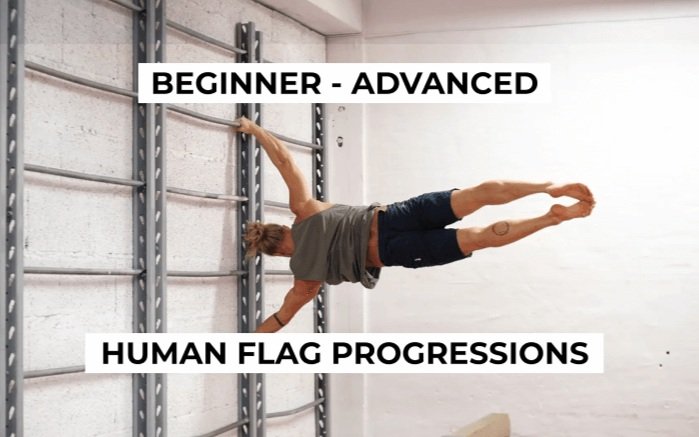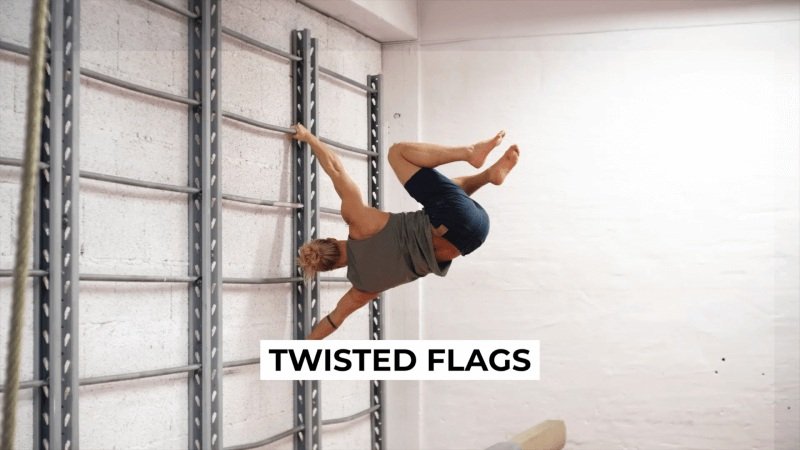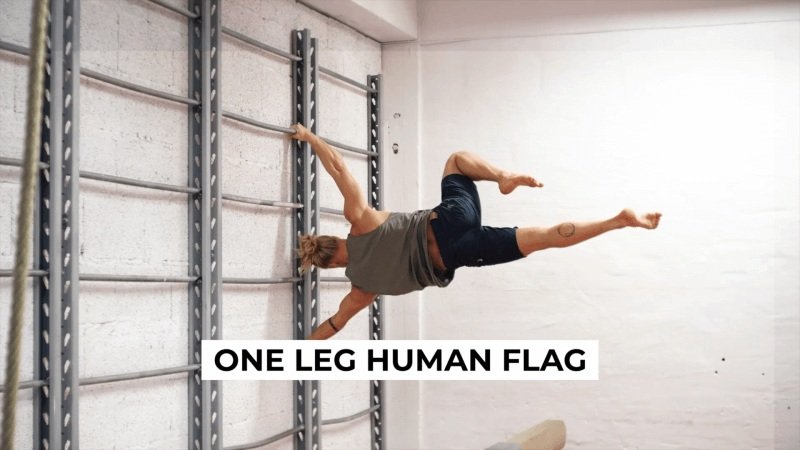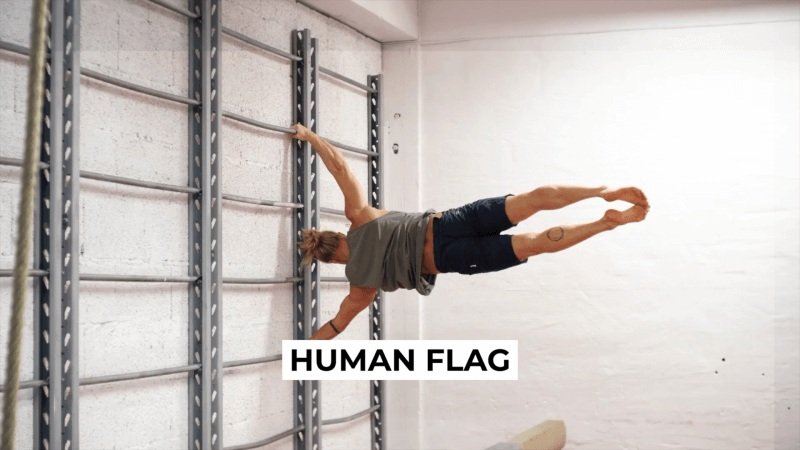Human Flag Progressions - Beginner to Advanced Progressions
Human Flag - how to start and how to progress
The human flag is yet another sweet calisthenics move, and actually was one of the first goals I strived towards way back when I first got into calisthenics. In this piece I will keep things straightforward, simply covering the human flag progressions and drills from beginning to end.
Jump to 6:40 in the video to get straight to the progressions!
However, for those who are looking for a deep dive on the human flag, keep an eye out in the coming week for a second piece on the human flag. In that piece, I will look deeper into the physics and biomechanics of the human flag, as well as analyze Geek Climber’s evaluation on this movement. Between these two pieces, I hope to cover everything you need to know to get started on and eventually master this cool skill.
If, after checking out the video and reading through this piece as well as next week’s deep dive, you find you still would like more guidance, information and instruction regarding the human flag or any other calisthenics movement, head over to my app and take a look around.
Depending on where you are currently at in terms of your calisthenics strength and fitness, some of the earlier progressions may come easy. Once you’re comfortable with a given progression, move on to the next one.
Let’s get right into it.
In this piece and in the youtube video, I do an analysis on Geek Climber’s evaluation of the human flag, as well as a run-through on all the progressions you need to learn to reach the human flag.
Human Flag Prerequisites
The first move that I think you should be comfortable with on your human flag journey is called the One Arm Inverted Support, as well as a One Arm Active Hang.
After you’ve got those two exercises down, you can get started on actual human flag-oriented exercises.
Human Flag - How to grip
Before we get into these exercises, let’s quickly go over the different grips you can use when doing the human flag.
Stall bars (which will be horizontal/parallel to the ground) and poles (which will be vertial/perpendicular to the ground) are the two main pieces of equipment you will use to do the human flag. In my opinion, stall bars are the easiest to use.
One important thing to keep in mind if you are indeed using stall bars for your human flag progressions, is to ensure that your hands are in line with each other. That is, each hand is directly above/below the other.
Placing your hands along the side of the stall bars, where each hand is touching the side, will ensure that your hands are properly in line.
It will be pretty easy to tell whether your hands are in line or not because, if they aren’t, you will start rotating. However, to make sure they are precisely in line, you may use the side of the stall bars as a guide for putting your hands, to make sure they are in line. If your top hand as well as your bottom hand are both touching the side of the stall bar, you can be sure your hands are in proper alignment.
If you want more information and instruction on each progression you can head over to my app where I have a full program dedicated to learning the Human Flag
Human Flag Training Program and Prep Program
If you are looking for more detailed instructions on how to progress through each step of the human flag journey, then feel free to head over to my app. There you will find a complete program dedicated to learning the human flag. If, however, you feel you might need some work before even getting started on the pathway above, I’ve also created a Human Flag Prep Program. This prep program will fully prepare you to get started on the human flag progressions covered here.
Human Flag First Steps
With the grip now taken care of, let’s get straight into the path you may take, from beginner to advanced level, to master the human flag.
The first step to doing the human flag is learning to push with the lower arm, and pull with the upper arm. Eventually, the goal will be to learn to perform a stable Downwards Low Flag.
Downward low flag - one of the first progressions to master if you want to learn the human flag
The next step will be learning to turn out your chest as pictured, to do the Low Flag. In mastering the Low Flag you will start to build control in your shoulders.
The low flag progression will teach you how to maintain a stable shoulder position in your human flag
Raise Your Human Flag
Next step on the ladder (no pun intended) is to climb up into an inverted position and support yourself with your feet. You can experiment with using less and less support from your feet until, eventually, you reach the High Flag. The High Flag will be the base position for the rest of your human flag training.
The high flag is perhaps one of the most important steps in learning the human flag.
Once we’ve achieved a stable High Flag position, we can get started on High Flag Swing Ups.
The high flag swing ups teaches you the most convenient way of entering a high flag position which will make your human flag training much more efficient.
Angled human flag - build strength and positional awareness!
From High Flag Swings Ups, we move on to lowering down to Angled Flags, pictured here. Two examples of an Angled Flag is the Tuck Angled Flag, as well as the One Legged Angled Flag.
tucked angled human flag progression
One leg angled human flag progression
twisted human flag - almost perfect!
The next progression after the Angled Flag is the Twisted Flag. As you develop more strength, you want to start to bring your body more and more parallel with the ground. One thing that will make things easier at first is to keep your chest facing slightly upwards. So, with the Twisted Flag, bring your body more parallel to the ground, but keep your chest facing slightly upwards to ease into the more difficult position.
These twisted human flag variations can be performed in tuck, one leg, straddle, half lay as well as full positions.
Twisted human flag. This showcases the tuck progression, but it can be performed with all advanced progressions such as in a straddle, one leg, or full twisted human flag. By twisted i mean chest turned upwards instead of straght forwards as in a perfect human flag.
Intermediate/advanced human flag progressions
After the Twisted Flag comes the Tucked Human Flag. Now it’s time to point your chest out the proper way, rather than upwards. At first, tuck your legs in (hence the name Tucked Human Flag) rather than have them straight out, to build up the necessary strength.
Tucked human flag progression
After the Tucked Human Flag, you’ll move on to the One Leg Human Flag.
One leg human flag progression
After the One Leg Human Flag comes the Straddle Human Flag.
Straddle human flag progression
Next - almost there! - is the Half Lay Human Flag.
Half lay human flag progression. the half lay position is often forgotten in many lever exercises, but is an invaluable step in learning a full anything (human flag, planche, front lever etc.)
Finally, after having worked through all of the above progressions, you arrive at the full Human Flag. However, your progression doesn’t need to stop there, as you can move on to Dynamic Human Flag training after this if you like. In fact, if you use easier positions, such as the Tuck Human Flag, you can implement Dynamic Human Flag training earlier on in your Human Flag journey.
The full human flag
A quick look at dynamic human flag training
One thing to keep in mind with these progressions is that many of them are technical in nature. It is therefore important to learn each one well before moving on to the next, in order to approach the human flag in the safest way possible.
Human Flag Summary
Let’s summarize the entire path of progressions from start to finish:
Pre-requisites: One Arm Inverted Support + One Arm Active Hang
Downwards low flag
Low flag
High flag (the foundation for the rest of the human flag progressions)
High flag swing ups
Angled flags
Twisted flags
Tucked human flags
One Leg human flag
Straddle human flag
Half lay human flag
Human flag
Dynamic Human Flag Training
If you’re new to the human flag and were looking to get an idea on how to approach it, I hope this has helped create some sort of path for you to try to follow.
Share Post!
Leave a Comment :)

















